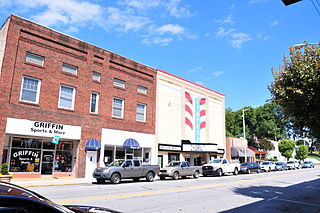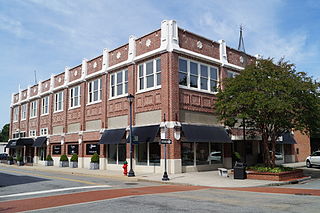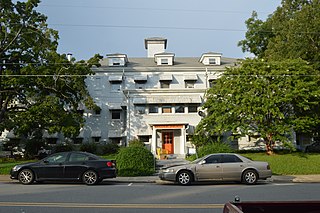
The New Hill Historic District is a national historic district located at New Hill, North Carolina, an unincorporated community in southwestern Wake County. The district encompasses the commercial and residential center and includes 2,820 acres (11.4 km2), 59 buildings, and one structure. The district developed between about 1860 and 1950, and includes notable examples of Colonial Revival and Tudor Revival style architecture. Notable buildings include the W. T. Roundy commercial complex, C.J. Bright's general merchandise store or New Hill Emporium, W. T. Roundy House, Duncan Lashley House, John Bright House, New Hill Baptist Church, Glass-Gardner House, and several farm complexes.

The Downtown Main Street Historic District is a national historic district located at North Wilkesboro, Wilkes County, North Carolina. It encompasses 29 contributing buildings in the central business district of North Wilkesboro. It developed between about 1891 and 1952, and includes notable examples of Classical Revival and Early Commercial style architecture. The architectural firm Benton & Benton designed the former Bank of North Wilkesboro II (1923), the Hotel Wilkes (1926), and the former Town Hall (1939). Other notable buildings include the Liberty Theater, former Bank of North Wilkesboro (1892), and Tomlinson Department Store (1927).

South King Street Historic District is a national historic district located at Morganton, Burke County, North Carolina. It encompasses 10 contributing buildings in Morganton. It includes residential, religious, and educational buildings built between about 1893 and 1939. It includes representative examples of Colonial Revival, Georgian Revival, and Gothic Revival style architecture. Notable buildings include the Grace Episcopal Church, Morganton Library, and Works Progress Administration constructed nurses' home.

Morganton Downtown Historic District is a national historic district located at Morganton, Burke County, North Carolina. It encompasses 62 contributing buildings in the central business district of Morganton. It includes commercial, industrial, and governmental buildings built between about 1889 and 1940. It includes representative examples of Classical Revival, Art Deco, and Italianate style architecture. Notable buildings include the Old Burke County Courthouse, Morganton Post Office, and the Morganton Community House.

Lenoir Downtown Historic District is a national historic district located at Lenoir, Caldwell County, North Carolina. The district includes 41 contributing buildings and 2 contributing objects in the central business district of Lenoir. It includes commercial, governmental, and institutional buildings in a variety of popular architectural styles including Art Deco, Art Moderne, Classical Revival and Tudor Revival. Notable contributing resources include the Center Theater (1941), O. P. Lutz Furniture Company and Lutz Hosiery Mill (1939), Dayvault's Drug Store (1937), Caldwell County Agricultural Building (1937), Courtney Warehouse, Masonic Hall, Miller Building, Confederate Monument (1910), Belk's Department Store (1928), Lenoir Building (1907), J. C. Penney Department Store, Fidelity Building (1928), and U. S. Post Office (1931). Located in the district is the separately listed Caldwell County Courthouse.

Downtown Mocksville Historic District is a national historic district located at Mocksville, Davie County, North Carolina. The district encompasses 21 contributing buildings and 1 contributing object in the central business district of Mocksville. It primarily includes residential and commercial buildings with notable examples of Classical Revival and Beaux-Arts style architecture. The district includes the previously listed Davie County Courthouse. Other notable buildings include the Davie County Jail (1916), (former) C. C. Sanford Sons Store (1937), (former) J. T. Baity/Anderson Store, (former) Meroney Hardware Company Building (1922-1924), Sanford Brothers Building (1927), (former) Southern Bank &. Trust Company Building (1923), (former) Princess Theatre, J. T. Angell Building (1910), Horn Service Station, (former) Kurfees and Ward Pure Oil Station, (former) Meroney Filling Station, and Johnstone Office Building (1939).

Farmington Historic District is a national historic district located at Farmington, Davie County, North Carolina. The district encompasses 87 contributing buildings, 2 contributing sites, and 3 contributing objects in the unincorporated community of Farmington. It primarily includes residential, agricultural, commercial, religious, and educational buildings with notable examples of Greek Revival, Italianate, Queen Anne, American Craftsman, and Colonial Revival style architecture. Notable contributing resources include the Farmington Community Cemetery (1881), Wiseman-Kennen House (1873), Dr. Lester P. and Helen Bahnson Martin House, Williard Garage (1920s), Francis Marion Johnson Store, Charles F. and Jane A. Bahnson House, Jarvis-Horne Store, Brock Marker, Farmington School Auditorium, Cafeteria, and Home Economics Classroom, Farmington School Agricultural Building (1936), (former) Farmington Baptist Church (1882), Farmington Methodist Church, and Farmington Post Office/Barber Shop.

Foster and West Geer Streets Historic District, also known as the West End, is a national historic district located at Durham, Durham County, North Carolina. The district encompasses 32 contributing buildings, 1 contributing site, and 4 contributing structures in a commercial section of Durham. The buildings primarily date between about 1927 and 1963 and include notable examples of Moderne, Colonial Revival, and Mission Revival architecture. Located in the district are the separately listed City Garage Yard and Fire Drill Tower and Scott and Roberts Dry Cleaning Plant, Office, and Store. Other notable contributing resources include R. J. Reynolds Tobacco Company warehouse (1938), the Durham Baking Company (1938), Durham Bulls baseball team ballpark (1939), Fletcher's Service Station, U.S. Naval Reserve Training Center, Uzzle Motor Company, King's Sandwich Shop (1950), and Royal Crown and Seven-Up Bottling Company (1939).

Downtown Gastonia Historic District is a national historic district located at Gastonia, Gaston County, North Carolina. It encompasses 77 contributing buildings and 1 contributing object in the central business district of Gastonia. The commercial, civic, institutional, and multi-unit residential buildings were built between the 1890s and 1954, and include notable examples of Colonial Revival and Classical Revival architecture. Located in the district are the separately listed former Gaston County Courthouse, First National Bank Building, Third National Bank Building, and Robinson-Gardner Building. Other notable buildings include the U.S. Post Office (1935), York Medical Building (1938), Kress Department Store, Leibowitz Department Store, Ideal Moving Picture Theater, City Hall, Kirby Building (1922), First Baptist Church (1922), Gaston County War Memorial Hall (1928), and the (former) Gaston County Public Library (1930).

Downtown Greensboro Historic District is a national historic district located at Greensboro, Guilford County, North Carolina. When first listed, the district encompassed 96 contributing buildings in the central business district of Greensboro. The commercial buildings were built between about 1885 and the 1930s in a variety of popular architectural styles including Italianate and Art Deco. Located in the district is the separately listed Jefferson Standard Building. Other notable buildings include the Vanstory Building, Kress Building (1929), Woolworth's, Efrid's Department Store, Montgomery Ward (1936), the Carolina Theatre (1927), Center Theatre (1948), the former Belk Building (1939), Ellis Stone/Thalhimer's Department Store (1949-1950), and the former American Exchange National Bank Building (1920). The Woolworth's store is notable as the site of the Greensboro sit-ins of 1960.

Main Street Historic District is a national historic district located at Hendersonville, Henderson County, North Carolina. The district encompasses 65 contributing buildings in the central business district of Hendersonville. The commercial and governmental buildings include notable examples of Classical Revival architecture. Located in the district is the separately listed Henderson County Courthouse. Other notable buildings include the Huggins Building, Cole Bank Building, Justus Pharmacy, Davis Store block (1900), The Federal Building (1914), Maxwell Store Building, Pace's Market, J. C. Penney Building (1939), and Lampley Motors.

Four Oaks Commercial Historic District is a national historic district located at Four Oaks, Johnston County, North Carolina. It encompasses 29 contributing buildings and 1 contributing structure in the town of Four Oaks. It includes notable examples of Mission Revival style architecture and buildings dating from about 1890 to 1957. It includes commercial, residential, ecclesiastical, and educational structures. Notable buildings include the W.E. Stanley Store, Blake Adams Store (1904), Four Oaks Bank Building, Lassiter Building, W. D. Allen Building (1926), Four Oaks Drugstore (1937), Sinclair Gas Station.

Greenville Commercial Historic District is a national historic district located at Greenville, Pitt County, North Carolina. The district encompasses 51 contributing buildings in the central business district of Greenville. It includes buildings dated from about 1914 to 1952 and notable examples of Greek Revival and Queen Anne style architecture. Located in the district and listed separately are the Pitt County Courthouse (1911) by Milburn, Heister & Company and U.S. Post Office (1913). Other notable buildings include the Proctor Hotel (1911), Montgomery Ward Department Store (1929), Dail-Hodges Building (1919), Blount Building (1924), Greenville Bank and Trust, Smith Electric Building, Greenville Municipal Building (1929) designed by Benton & Benton, Blount-Harvey Department Store (1923), White's Theater (1914), Charles Greene House (1860), and the Robert Lee Humber House (1895).

Lumberton Commercial Historic District is a national historic district located at Lumberton, Robeson County, North Carolina. The district encompasses 64 contributing buildings and 1 contributing site in the central business district of Lumberton. It includes buildings built between about 1840 to 1941 in a variety of popular architectural styles including Classical Revival and Streamline Moderne. Located in the district are the separately listed Carolina Theatre and Planters Building. Other notable buildings include the Proctor Law Office, McLeod Building (1879), (former) National Hotel, (former) Efird's Department Store, Huggins Star Shoe Shop, National Bank of Lumberton (1914), Dresden Cotton Mills Office Building, (former) Lumberton Municipal Building (1917), and Stephens Funeral Home (1936).

Central Leaksville Historic District is a national historic district located at Eden, Rockingham County, North Carolina. It encompasses 67 contributing buildings, 2 contributing sites, and 1 contributing object in a residential section of the town of Eden. It was developed from about 1815 to about 1935, and includes notable examples of Italianate, Queen Anne, Colonial Revival, and Bungalow style architecture. Notable buildings include the Rogers-Martin-Taylor House, Saunders-Hege House, Robinson-Dillard-Martin House, Lawson-Moir-Clayton House, Episcopal Church of the Epiphany (1844), J. M. Hopper House (1885), Norman-DeHart House, and Casteen House.

Spray Industrial Historic District is a national historic district located at Eden, Rockingham County, North Carolina. It encompasses 70 contributing buildings, 9 contributing structures, and 1 contributing object in an industrial section of the town of Eden. It includes buildings associated with eight textile mill complexes, mill village housing, and seven commercial buildings. Notable contributing resources include the Smith River Dam and Spray Power canal, Morehead Cotton Mill complex, "Superintendent's" House, Imperial Bank and Trust Company (1912), Leaksville Cotton Mills complex, Spray Mercantile Building, Spray Cotton Mills complex, Lily Mill complex, Nantucket Mills complex designed by R. C. Biberstein, American Warehouse Company complex, Rhode Island Mill complex, Phillips-Chatham House, and Spray Woolen Mill complex.

Clinton Commercial Historic District is a national historic district located at Clinton, Sampson County, North Carolina. The district encompasses 67 contributing buildings and 4 contributing objects in the central business district of Clinton. It developed between about 1902 and 1951, and includes notable examples of Colonial Revival, Tudor Revival, and Classical Revival architecture. Located in the district are the separately listed Bethune-Powell Buildings, Clinton Depot, and Johnson Building. Other notable buildings include the Sampson County Courthouse, Bank of Sampson (1902), Henry Vann Building (1924), William's Building, DuBose Building (1938), and U. S. Post Office (1936) designed by the Office of the Supervising Architect under Louis A. Simon.

Laurinburg Commercial Historic District is a national historic district located in Laurinburg, North Carolina. The district encompasses 51 contributing buildings and 2 contributing structures in the central business district of Laurinburg.

Downtown Elkin Historic District is a national historic district located at Elkin, Surry County, North Carolina. The district encompasses 51 contributing buildings and 2 contributing structures in the central business district of Elkin. They were primarily built between about 1890 and 1950 and include notable examples of Early Commercial and Bungalow / American Craftsman architecture. Notable buildings and structures include the Gwyn-Foard House, Hugh G. Chatham Bridge (1931), Liberty Tobacco Warehouse, Harris Building (1902), U.S. Post Office (1937) designed by the Office of the Supervising Architect under Louis A. Simon, former Elkin Town Hall (1938–1939) built by the Works Progress Administration, Dobbin's Store, and the Riverside Hotel (1915–1925).

Main Street Historic District is a national historic district located at Brevard, Transylvania County, North Carolina. It encompasses 32 contributing buildings in the central business district of Brevard. The district developed between about 1874 and 1952 and includes notable examples of Early Commercial, Second Empire, and Classical Revival style architecture. Located in the district are the separately listed McMinn Building and Transylvania County Courthouse. Other notable buildings include the Lowe Auto Company, Brevard Banking Company (1924), Brevard Drugs/Mull's Grocery, Brevard City Hall and Fire Station (1926), Plummer's Department Store (1911), Brevard Banking Company (1924) designed by Erle Stillwell, Co-ed Theater (1939), Pearlman's (1952), Aethelwold Hotel, and City Market.
























